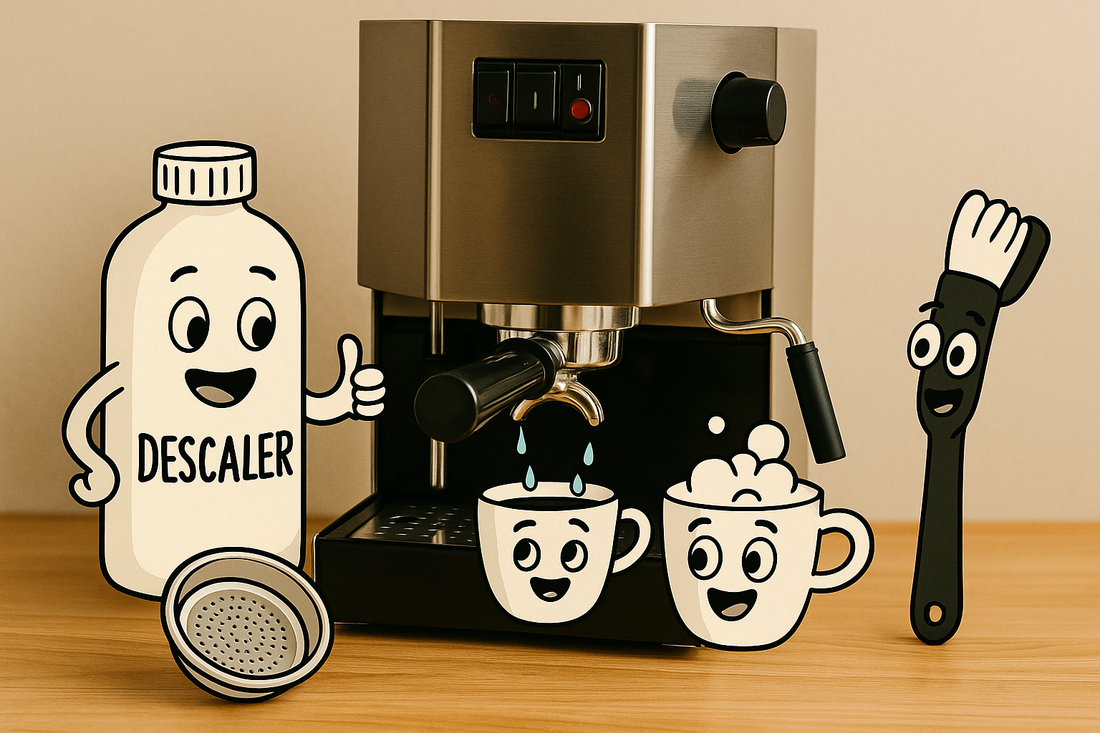
The Home Barista’s Guide to Espresso Machine Maintenance
Share
The Home Barista’s Guide to Espresso Machine Maintenance
Because great coffee starts with clean, consistent equipment.
If you’re serious about making great espresso at home, you’ve probably invested time and money into a solid machine, a quality grinder, and some excellent beans. But there’s one more ingredient many home baristas overlook: maintenance.
Cleaning and maintaining your espresso machine isn’t just about longevity — it’s about flavour. Neglect leads to sour shots, bitter aftertastes, inconsistent performance, and eventually costly repairs. Thankfully, a little regular care goes a long way.
Whether you’re new to espresso or a seasoned home brewer, this guide will walk you through how to care for your espresso machine — clearly, thoroughly, and without unnecessary jargon.
Why Maintenance Matters
Espresso is an unforgiving brew method. Even small variables — temperature, pressure, cleanliness — can drastically affect the flavour in your cup. Coffee oils, fine grounds, and hard water deposits build up over time, blocking filters, souring your shots, and overworking your machine’s internal parts.
A clean machine doesn't just taste better — it works better.
Daily Maintenance: Build Good Habits
These small, quick steps make a big difference when done every day:
1. Flush the Group Head
After each shot, run hot water through the group head (where the portafilter locks in) for 2–3 seconds. This clears out spent coffee oils and particles before they dry and clog the system.
2. Purge and Clean the Steam Wand
After steaming milk, immediately wipe the wand with a damp cloth and purge it by releasing a quick blast of steam. This prevents milk residue from drying inside the wand and turning into burnt gunk — which can smell and taste awful.
3. Empty the Drip Tray and Grounds Bin
Don’t let stale water or used coffee pucks sit in the machine. Rinse and dry these parts regularly to avoid mould and unpleasant odours.
Weekly Maintenance: Deeper Cleaning
Think of this as your espresso machine’s version of a Sunday reset.
1. Backflushing (If Your Machine Supports It)
If your machine has a three-way solenoid valve (common on many prosumer and mid-range machines), you should backflush once or twice a week. This involves running water — with and without detergent — backward through the group head to clear internal valves and pathways.
What You’ll Need:
- A blind basket (a filter basket with no holes)
- A group head cleaner (e.g., Cafiza or similar)
How To:
- Insert the blind basket into your portafilter with a small amount of cleaner.
- Lock it in and run the pump for 10 seconds, then rest for 10.
- Repeat 5–7 times.
- Rinse thoroughly with clean water to remove any residue.
💡 If your machine doesn’t support backflushing, skip this step and focus on descaling and manual part cleaning.
2. Soak Your Parts
Remove the portafilter basket, shower screen (if accessible), and any removable spouts. Soak them in warm water with a bit of espresso cleaner, then scrub and rinse.
Monthly Maintenance: The Health Check
1. Descale the Machine
Scale is mineral buildup from water — mostly calcium and magnesium — that can clog pipes, affect heat transfer, and damage pumps or boilers over time.
Use a food-safe descaling solution, diluted according to the manufacturer’s instructions, and run it through the machine’s brew and steam paths. Let it sit briefly before flushing the system with multiple tanks of clean water.
💡 If you live in a hard water area, descale more often — or consider using filtered or bottled water designed for coffee machines.
2. Inspect Your Group Gasket
The rubber or silicone ring that seals your portafilter into the group head can harden or crack. If you notice water leaking around the handle during a shot, it's time to replace it — an easy and inexpensive fix.
Every 6–12 Months: Reboot and Refresh
1. Replace the Group Head Gasket and Shower Screen
Even if they look fine, these parts degrade subtly over time and can affect pressure and flow. Replacing them yearly keeps your extractions even and reliable.
2. Check the Steam Wand Tip
Use a pin to make sure the holes in your steam wand tip are clear. Milk residue can clog them, reducing steam pressure and texture quality.
3. Consider Simple Upgrades
Many home machines can be improved with better baskets, upgraded steam wands, or precision shower screens. These upgrades aren’t essential, but they can improve consistency and control.
Essential Cleaning Supplies
Keep these on hand:
- Espresso machine cleaner (like Cafiza)
- Descaling solution
- Group head brush
- Blind basket (for backflushing)
- Spare group gasket and shower screen
- Food-safe silicone grease (for steam valve threads or o-rings)
Frequently Asked: What About Super-Automatic Machines?
If your machine grinds, doses, and brews at the push of a button, it likely has built-in maintenance cycles. Use the machine’s prompts — but also check the manual for how to clean the brew unit and descale manually. Many users forget this step, leading to clogs and bitter-tasting coffee.
Watch and Learn
For those who like to see the process, here’s a superb visual resource with step-by-step videos:
▶️ Whole Latte Love – Cleaning & Maintenance Tutorials
Looking for Spare Parts or Upgrades?
Whether it’s a new group gasket, a bottomless portafilter, or a pro-level steam wand, a well-stocked parts shop makes maintenance easier:
🧰 Shades of Coffee – Accessories & Parts
Final Thought: Don’t Blame the Beans
When your espresso starts tasting “off,” it’s tempting to blame the roast or your grinder. But often, it’s your machine asking for a little love.
Clean machines pull cleaner shots. They last longer. And they let your coffee shine.
